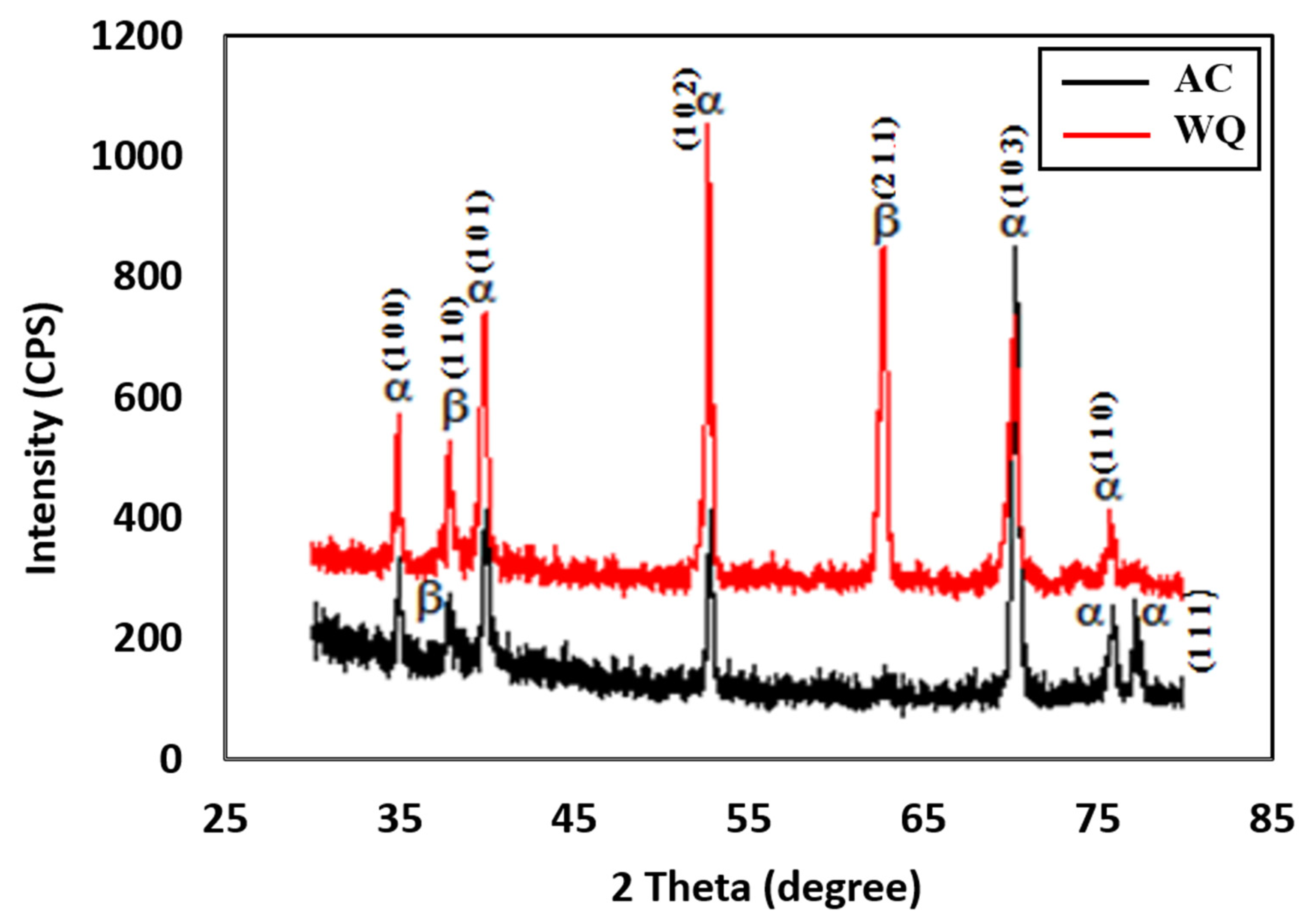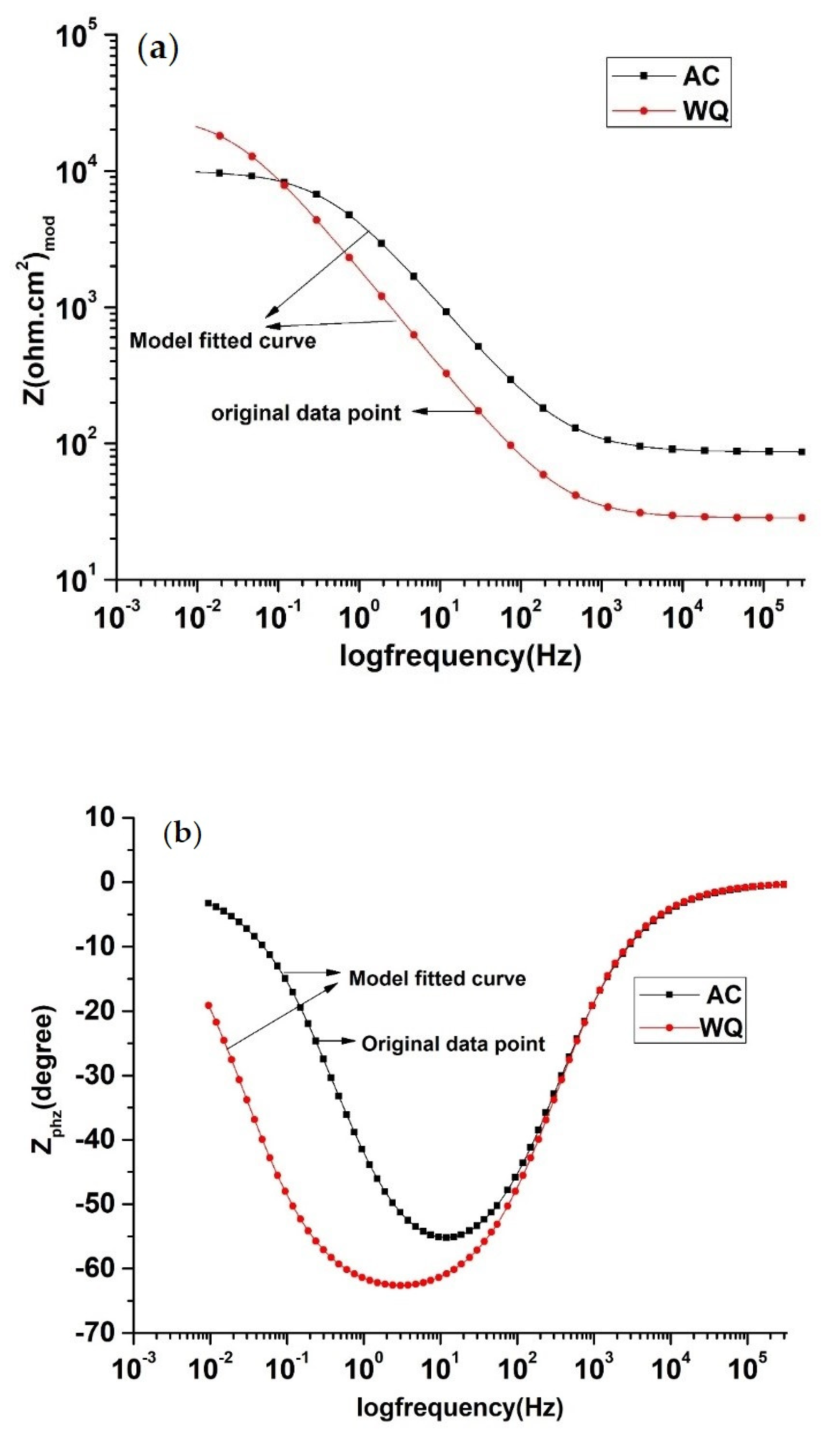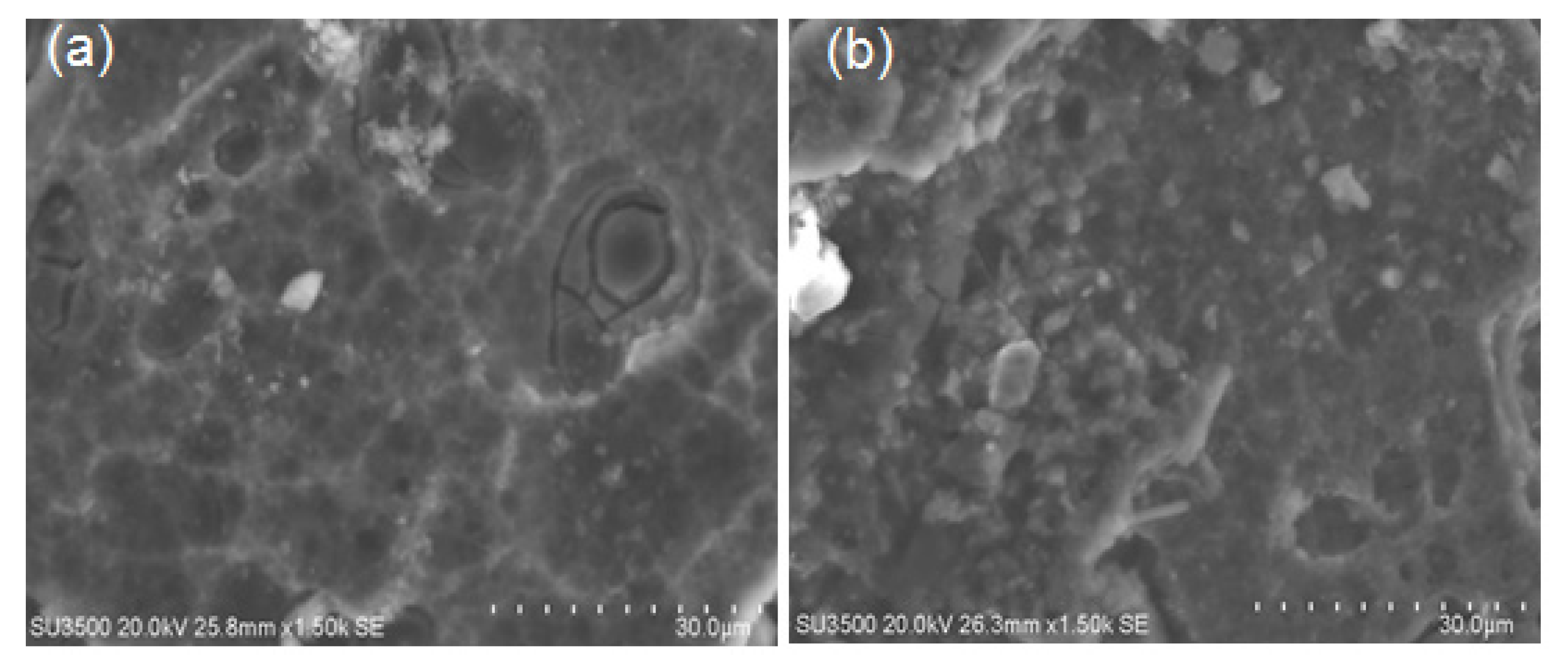A Comparative Study of the Electrochemical Behavior of α and β Phase Ti6Al4V Alloy in Ringer’s Solution
Abstract
:1. Introduction
2. Materials and Methods
2.1. Sample Preparation
2.2. Heat Treatment of Ti-6Al-4V Alloy
2.3. Microstructure
2.4. XRD Analysis
2.5. Corrosion Rate Measurement
2.6. Electrochemical Impedance Spectroscopy
3. Results and Discussions
4. Conclusions
Author Contributions
Funding
Conflicts of Interest
References
- Jacobs, J.J.; Gilbert, J.L.; Urban, R.M. Corrosion of metal orthopaedic implants. J. Bone Jt. Surg. Ser. A 1998, 80, 268. [Google Scholar] [CrossRef]
- Jon Goldberg, A.; Kuhn, L.T. Biomaterials. In Regenerative Engineering; Laurencin, C., Khan, Y., Eds.; Taylor and Francis Group: Oxfordshire, UK, 2012; p. 30. ISBN 9781482216837. [Google Scholar]
- Aragon, P.J.; Hulbert, S.F. Corrosion of Ti-6Al-4V in simulated body fluids and bovine plasma. J. Biomed. Mater. Res. 1972, 8, 155. [Google Scholar] [CrossRef] [PubMed]
- Mueller, H.J.; Greener, E.H. Polarization studies of surgical materials in ringer’s solution. J. Biomed. Mater. Res. 1970, 1, 4–29. [Google Scholar] [CrossRef] [PubMed]
- López, M.F.; Gutiérrez, A.; Jiménez, J.A. In vitro corrosion behaviour of titanium alloys without vanadium. Electrochim. Acta 2002, 47, 1359–1360. [Google Scholar] [CrossRef]
- Singh, R.; Dahotre, N.B. Corrosion degradation and prevention by surface modification of biometallic materials. J. Mater. Sci. Mater. Med. 2007, 18, 731–732. [Google Scholar] [CrossRef]
- Nikolova, M.P.; Yankov, E.H. Corrosion study of Ti5Al4V and Ti6Al4V in different simulated body fluids. In Materials Design and Applications II; Springer: New York, NJ, USA, 2019; pp. 39–58. [Google Scholar]
- Mareci, D.; Chelariu, R.; Gordin, D.M.; Ungureanu, G.; Gloriant, T. Comparative corrosion study of Ti-Ta alloys for dental applications. Acta Biomater. 2009, 5, 3625–3639. [Google Scholar] [CrossRef]
- Donachie, M.J., Jr. Heat treating titnium and its alloys. In Heat Treating in Titanium: A Technical Guide; ASM International: Cleveland, OH, USA, 2016; pp. 511–534. [Google Scholar]
- El-Hadad, S.; Nady, M.; Khalifa, W.; Shash, A. Influence of heat treatment conditions on the mechanical properties of Ti–6Al–4V alloy. Can. J. Metall. Mater. Sci. 2018, 57, 186–193. [Google Scholar] [CrossRef]
- Liu, W.; Lin, Y.; Chen, Y.; Shi, T.; Singh, A. Effect of Different Heat Treatments on Microstructure and Mechanical Properties of Ti6Al4V Titanium Alloy. Xiyou Jinshu Cailiao Yu Gongcheng/Rare Met. Mater. Eng. 2017, 46, 634–639. [Google Scholar]
- Dai, N.; Zhang, J.; Chen, Y.; Zhang, L.C. Heat Treatment Degrading the Corrosion Resistance of Selective Laser Melted Ti-6Al-4V Alloy. J. Electrochem. Soc. 2017, 146, 428–435. [Google Scholar] [CrossRef]
- Nong, Z.S.; Zhu, J.C.; Yu, H.L.; Lai, Z.H. First principles calculation of intermetallic compounds in FeTiCoNiVCrMnCuAl system high entropy alloy. Trans. Nonferrous Met. Soc. China 2012, 22, 1437–1444. [Google Scholar] [CrossRef]
- Mondal, D.P.; Jha, N.; Badkul, A.; Das, S. Effect of Al-TiB master alloy addition on microstructure, wear and compressive deformation behaviour of aluminum alloys. Trans. Nonferrous Met. Soc. China 2012, 22, 1001–1011. [Google Scholar] [CrossRef]
- Seagle, S.R. Titanium/titanum alloys. Adv. Mater. Process. 1993, 1, 1–6. [Google Scholar]
- Zoltan, K.; David, P. Mechanical properties of Ti-6Al-4V samples produced with additive technology. Mater. Today 2018, 5, 26558–26565. [Google Scholar]
- Boukamp, B.A. A Nonlinear Least Squares Fit procedure for analysis of immittance data of electrochemical systems. Solid State Ionics 1986, 20, 31–44. [Google Scholar] [CrossRef] [Green Version]
- Bisquert, J.; Garcia-Belmonte, G.; Bueno, P.; Longo, E.; Bulhões, L.O.S. Impedance of constant phase element (CPE)-blocked diffusion in film electrodes. J. Electroanal. Chem. 1998, 452, 229–234. [Google Scholar] [CrossRef]
- Niinomi, M. Mechanical properties of biomedical titanium alloys. Mater. Sci. Eng. A 1998, 243, 231–236. [Google Scholar] [CrossRef]
- Popa, M.V.; Vasilescu, E.; Drob, P.; Vasilescu, C.; Drob, S.I.; Mareci, D.; Rosca, J.C.M. Corrosion resistance improvement of titanium base alloys. Quim. Nova 2010, 33, 1892–1896. [Google Scholar] [CrossRef]
- Ijaz, M.F.; Vasilescu, C.; Drob, S.I.; Osiceanu, P.; Marcu, M.; Kim, H.Y.; Miyazaki, S.; Gordin, D.M.; Gloriant, T. Electrochemical characterization of the superelastic (Ti-Zr)-Mo-Sn biomedical alloy displaying a large recovery strain. Mater. Corros. 2017, 68, 1220–1227. [Google Scholar] [CrossRef]
- Heakal, F.E.T.; Awad, K.A. Electrochemical corrosion and passivation behavior of titanium and its Ti-6AL-4V alloy in low and highly concentrated HBr solutions. Int. J. Electrochem. Sci. 2011, 7, 6539–6554. [Google Scholar]
- Loveday, D.; Peterson, P.; Rodgers, B. Evaluation of organic coatings with electrochemical impedance spectroscopy: Part 1: Fundamentals of electrochemical impedance spectroscopy. CoatingsTech 2004, 2, 7. [Google Scholar]
- Shukla, A.K.; Balasubramaniam, R.; Bhargava, S. Properties of passive film formed on CP titanium, Ti-6Al-4V and Ti-13.4Al-29Nb alloys in simulated human body conditions. Intermetallics 2005, 13, 631–637. [Google Scholar] [CrossRef]
- Kobayashi, E.; Wang, T.J.; Doi, H.; Yoneyama, T.; Hamanaka, H. Mechanical properties and corrosion resistance of Ti-6Al-7Nb alloy dental castings. J. Mater. Sci. Mater. Med. 1998, 9, 567–574. [Google Scholar] [CrossRef] [PubMed]








| Element | Al | V | N | C | H | Fe | O | Ti |
|---|---|---|---|---|---|---|---|---|
| Wt.% | 6 | 4 | ≤0.03 | ≤0.08 | ≤0.013 | ≤0.20 | ≤0.15 | Bal. |
| WQ | AC | ||||
|---|---|---|---|---|---|
| 2θ | d Spacing | % I/I0 | 2θ | d Spacing | % I/I0 |
| 52.82 | 1.7318 | 100 | 70.46 | 1.3353 | 100 |
| 62.84 | 1.4776 | 67 | 52.90 | 1.7294 | 35 |
| 70.36 | 1.3376 | 53 | 40.02 | 2.2511 | 30 |
| 39.92 | 2.2595 | 52 | 35.04 | 2.5588 | 23 |
| 34.98 | 2.5631 | 33 | 55.36 | 1.6582 | 7 |
| 37.94 | 2.3696 | 27 | 38.38 | 2.3435 | 10 |
| Sample | Icorr (µA/cm2) | Ecorr (V vs. SCE) | βa | βc | Error | |
|---|---|---|---|---|---|---|
| icorr (µA) | Ecorr (mV) | |||||
| WQ | 0.2 | −0.322 | 0.120 | 0.168 | ±0.05 | ±10 |
| AC | 2 | −0.504 | 0.198 | 0.254 | ±0.4 | ±10 |
| Sample Name | Model Name | Rp (kΩ.cm2) | Ru (kΩ.cm2) | Y0 | α | Goodness of Fit |
|---|---|---|---|---|---|---|
| AC | CPE | 39.00e3 | 24.92 | 9.645 × 10−5 | 5.209 × 10−5 | 9.585 × 10−3 |
| WQ | CPE | 65.93e3 | 35.52 | 3.437 × 10−5 | 8.182 × 10−5 | 9.234 × 10−3 |
© 2020 by the authors. Licensee MDPI, Basel, Switzerland. This article is an open access article distributed under the terms and conditions of the Creative Commons Attribution (CC BY) license (http://creativecommons.org/licenses/by/4.0/).
Share and Cite
Luqman, M.; Seikh, A.H.; Sarkar, A.; Ragab, S.A.; Mohammed, J.A.; Ijaz, M.F.; Abdo, H.S. A Comparative Study of the Electrochemical Behavior of α and β Phase Ti6Al4V Alloy in Ringer’s Solution. Crystals 2020, 10, 190. https://doi.org/10.3390/cryst10030190
Luqman M, Seikh AH, Sarkar A, Ragab SA, Mohammed JA, Ijaz MF, Abdo HS. A Comparative Study of the Electrochemical Behavior of α and β Phase Ti6Al4V Alloy in Ringer’s Solution. Crystals. 2020; 10(3):190. https://doi.org/10.3390/cryst10030190
Chicago/Turabian StyleLuqman, Monis, Asiful H. Seikh, Amit Sarkar, Sameh A. Ragab, Jabair A. Mohammed, Muhammad Farzik Ijaz, and Hany S. Abdo. 2020. "A Comparative Study of the Electrochemical Behavior of α and β Phase Ti6Al4V Alloy in Ringer’s Solution" Crystals 10, no. 3: 190. https://doi.org/10.3390/cryst10030190






